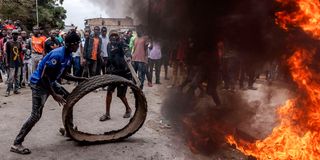Militancy moulds Kenyan politics

An opposition supporter pushes a tire in front of a burning barricade during protests against the high cost of living in Nairobi, Kenya on July 19, 2023.
During the Maandamano protests last week, one couldn’t help but feel that, in several places and some points, they were not propelled by the Azimio la Umoja, who have been calling them over the past few months. The scale of the protests spoke of a national organisational capability that the coalition has rarely shown, or if it has the ability, has done a good job of hiding it.
That presented both an opportunity and risk. It seemed to offer Azimio an easy path to grow its protests beyond the election grievance action they started out as into a big tent movement which mops up the cost of living issues that have sharpened over the past seven months. It could marginalise its leadership and hand the “ownership” of the demos to more militant actors, at least at the grassroots, but burden Azimio with an image of being reckless.
That is only one of the backstories of the protests as this week arrived to a call by Azimio to have three days of protest beginning Wednesday, July 19, 2023 and reports that President William Ruto had called on ruling UDA loyalists and politicians to stage counter pro-government protests.
The second backstory, perhaps a more interesting one, is how the protests are functioning as a sorting machine for future Kenyan leadership. The 2027 candidates, and rulers of the 2030s Kenya, are being made, and unmade, in Maandamano.
Kenya is unique among African countries that never had military rule and had continuous elections (including rigged ones during the one-party rule), in that its leaders emerge from the militant spectrum of politics.
In 1991, with the end of one-party rule, Frederick Chiluba won Zambia’s first post-independence multi-party presidential election as the candidate of the Movement for Multiparty Democracy (MMD) opposition grouping, defeating long-serving President Kenneth Kaunda.
Chiluba rose to political prominence as a trade union leader.
Wavel Ramkalawan has been the president of the Seychelles since October 2020. He was an opposition legislator and leader for most of the period from 1993 to 2020. His victory was the first for an opposition candidate since the island nation’s independence in 1976. He is/was an Anglican priest and broke into opposition politics after his scathing 1990 sermon against one-party rule that was broadcast on the national radio station. The sermon was cut quickly but the bit the Seychellois heard was enough. Ramkalawan had arrived.
Fiery churchmen
Kenya has had its fair share of fiery churchmen who become influential figures, especially, during the 1980s and ’90s democracy movement. But none of them converted it into a successful political career. The reason for that, again, was the lack of the hard militant factor which is reflected in the political fortunes of President Ruto and his previous leader-turned-foe, former President Uhuru Kenyatta.
Kenyatta ran as the candidate for the Kanu party in 2002, taking over from Daniel arap Moi, who had been president since 1978. Kenyatta was beaten like a drum by the opposition candidate Mwai Kibaki.
Kenyatta’s rise to the presidency was then cemented in the post-election violence of late 2007 to early 2008. He and Ruto were charged by the International Criminal Court (ICC) with crimes against humanity arising from the violence—on which they were on opposite sides.
The cases would crumble. But, for better or worse, Kenyatta emerged as a protector of the ‘Mountain’ people and Ruto a champion of the dispossessed of the Rift Valley. Their supporters saw them as generals who had been nailed to the cross in a conspiracy by global and local “dark forces”.
They had been drenched in the blood of martyrdom. When they ran on a joint ticket in 2013 , they took the election. The Kenyatta of 2002 had been elevated by battle. The Ruto who had lost as the Orange Democratic Movement (ODM) party, leader Raila Odinga’s running mate had undergone a baptism of fire at ICC.
So, here we are again. On the side of the ruling United Democratic Alliance (UDA), the picture isn’t clear how the response to Maandamano plays into the future. The government is torn between being seen as a pragmatic dealmaker with an opposition that has the bigger national interest at heart and a brawler keen to beat down the opponent so that it doesn’t appear weak. The central Kenya UDA politicians seem to be clearest: They see it as an opportunity to destroy the Kenyatta political infrastructure in the region.
Nairobi Senator and ODM Secretary-General Edwin Watenya Sifuna seems to have gripped the bone more firmly in his jaws than anyone else in the opposition. It helps that he has got many gifts in one packet: Dark and handsome, clever, fast-mouthed, quick-footed, media savvy and some guts too. He is playing it like a harp.
Former Raila running mate Martha Karua is delivering sharp barbs. Kalonzo Musyoka has chosen a different path. He is more steadfast than ever and more magisterial and princely. We will know soon who the gods of Kenyan politics have favoured.
Mr Onyango-Obbo is a journalist, writer and curator of the "Wall of Great Africans". @cobbo3





